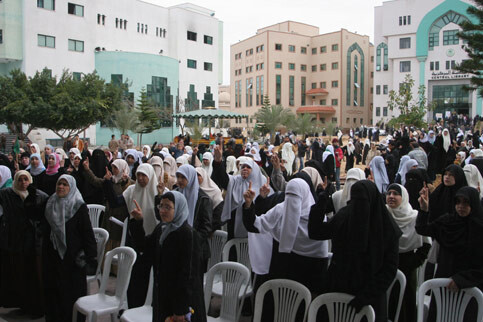The Electronic Intifada 5 February 2007

Palestinian students from the Islamic University protest against the attack on their university three days ago, Gaza City, 5 February 2007. (MaanImages/Hatem Omar)
GAZA CITY, Feb 5 (IPS) - The United Nations has indefinitely suspended elementary school classes for tens of thousands of Gaza City’s children following a weekend of unprecedented factional violence, which turned this isolated enclave into a war zone and left at least 27 dead and 250 wounded.
John Ging, director of operations for the United Nations Relief and Works Agency for Palestine Refugees in the Near East (UNRWA) said, “we try to balance the risk of violence to kids and parents on the one hand, and the need for these kids to get an education on the other.
“The intensity of the fighting was such that we had no choice,” Ging told reporters in Gaza.
The suspension of classes in Gaza City impacts dozens of UN schools, many of which are situated in immediate conflict areas.
The majority of Gaza’s students are in the UN school system.
While classes have been cancelled on numerous occasions because of Israeli army operations in Gaza, particularly since the Palestinian uprising began in September 2000, the UN told IPS that this is the first time that classes have been officially suspended because of the internal fighting.
The cancellation of classes will be reviewed on a day by day basis, according to the UN, but the situation is aggravated by the nature of the fighting which is often chaotic and unpredictable, with gunfights breaking out on busy streets without warning.
“We cannot leave children’s lives to prediction,” UNRWA spokesperson Adnan Abu Hasna told IPS.
Makeshift roadblocks manned by armed militants have been erected throughout Gaza City, and sandbag bunkers are a prominent feature on street corners.
Fierce gunfights, grenade attacks and mortar fire have all but turned this coastal strip into a ghost town.
Bustling markets are deserted and the shops have their steel doors locked. Gaza’s people are essentially house-bound. Gunfire could be heard throughout Gaza City Sunday night, despite a purported ceasefire.
Nine similar ceasefire agreements have collapsed in the last 15 days.
Fighting between militias of the elected Hamas government and U.S.-backed security forces loyal to Fatah President Mahmoud Abbas has escalated since December.
Six United Nations agencies active in the Gaza Strip issued a statement Sunday warning that the security situation is deeply disrupting the delivery of essential assistance, noting that the “implications for a population facing extreme hardship are grave.”
At least 1.1 million of Gaza’s 1.5 million people receive UN assistance. Most of Gaza’s residents are registered refugees who fled their homes in what is now Israel in 1947 and 1948.
The agencies, including UNRWA, UNDP and UNICEF also condemned “in the strongest possible terms” the killing of civilians.
Four children were among those killed in crossfire in the last three days.
On Friday, 20-year-old Wasi Kurdish was killed when he was struck in the chest by a bullet while watching television in his home.
“We have been warning repeatedly that the situation (in Gaza) was heading for social explosion — now it has come,” said Ging.
Fighting erupted between the two largest political factions in the Palestinian political arena shortly after Fatah President Abbas threatened to call early elections late last year in order to break a deadlock in negotiations over a national unity government.
The aim of a national unity government is to end the international sanctions regime imposed on the Hamas-led Palestinian government since the Islamist movement formed a government shortly after winning parliamentary elections in January 2006.
The sanctions regime has led to protracted strikes and walkouts throughout all sectors of Palestinian society, and has demonstrably diminished resources within the education system, according to the head of Gaza’s largest teacher’s union.
Jamil Shehadeh, secretary general of the Union of Palestinian Teachers said that 72 days have been lost this school year to strikes, and the second semester is only just beginning.
Teachers in Palestinian Authority schools have been paid their salaries — about 350 dollars a month — only three of the last 11 months.
“The situation is untenable. It is our responsibility to the students and it demands a solution,” Shehadeh told IPS.
Fatma Shaheen, a third grade Arabic teacher, said that the fighting has taken a significant toll on children’s ability to learn beyond simply the number of school days lost.
“The children are traumatised and afraid to come to school — once they are here, they are afraid to go outside again.”
Shaheen said that the factional violence cannot be separated from the ongoing violence of the 40-year Israeli occupation of Gaza, and the children relive terrible experiences of the last seven years of the Palestinian uprising.
“The children hide under their desks when they hear the shooting,” she said, adding that bed-wetting has been a consequence of the constant fear and violence that is an unavoidable part of childhood in the Gaza Strip.
Rather than fire drills, in the elementary schools in the Palestinian territories children routinely practice “tank drills”, where they duck under their desks to brace against an Israeli attack.
Several children have been killed and injured by Israeli army sniper fire while sitting in class at UN schools in the Palestinian territories, particularly in Gaza where 1.5 million people live in some the world’s most densely populated conditions.
In the face of the infighting, the sanctions and the Israeli occupation, Shaheen expressed a common sentiment on the streets of Gaza: “This is all a deadly theatre, directed by the Israelis. The only one who benefits from this strife is Israel, and all those involved in the fighting are simply collaborators.”
All rights reserved, IPS – Inter Press Service (2007). Total or partial publication, retransmission or sale forbidden.
Related Links



